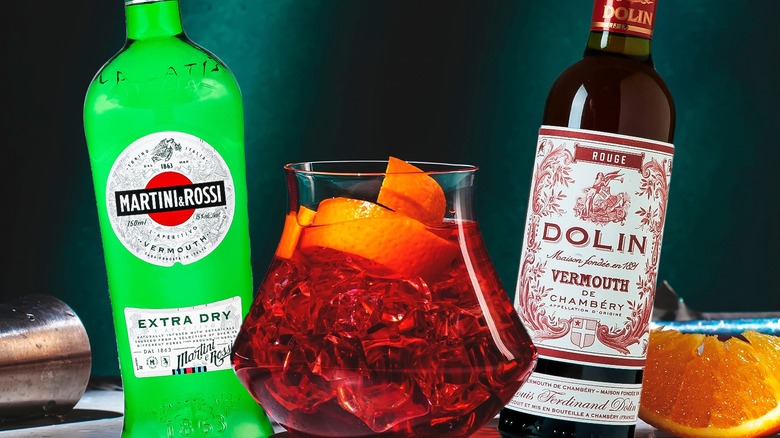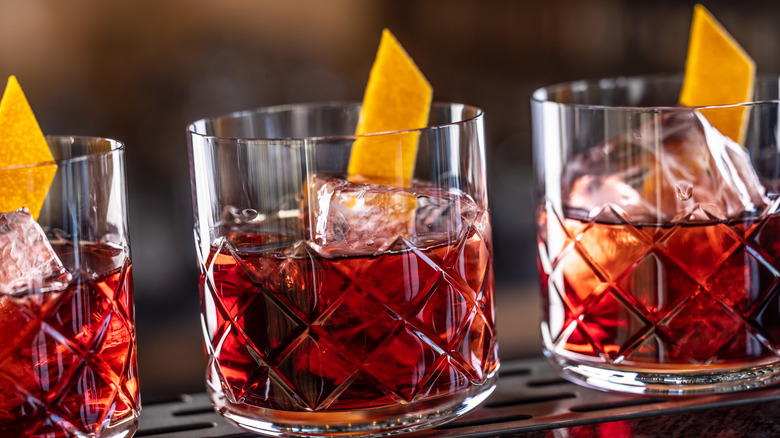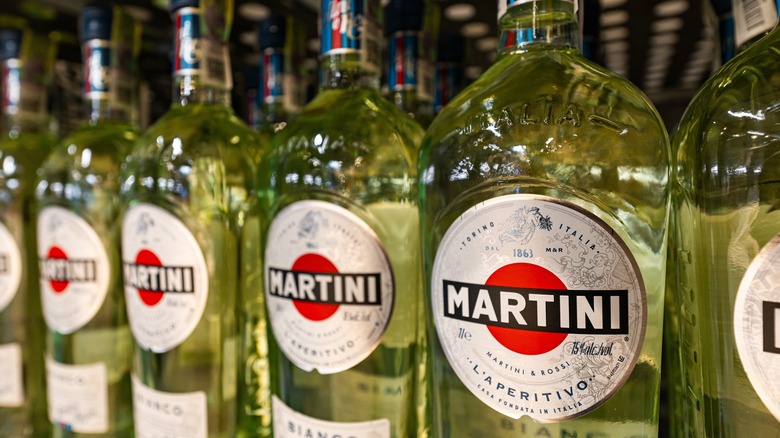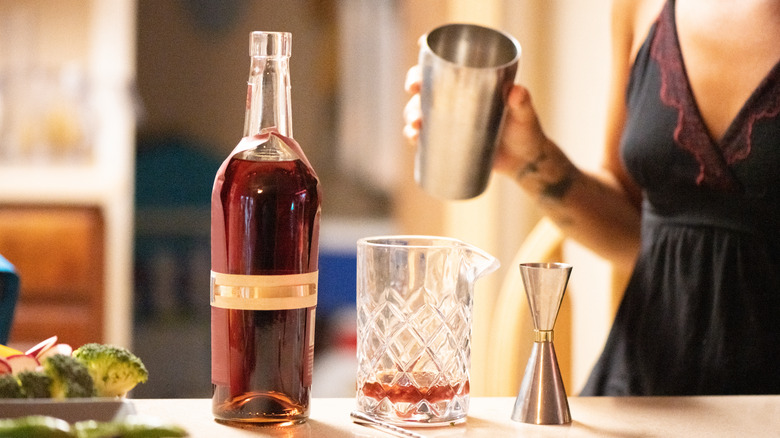7 Tips For Adding Vermouth To Mixed Drinks, From A Certified Sommelier
While vermouth is a common ingredient in some mixed drinks, it remains a bit of a mystery to many. It's got a history built abroad and has splashed its way into famous cocktails served at bars around the world. Yet, vermouth can feel somewhat of a niche beverage or a distant relative of wine (because it pretty much is). It's a key ingredient to classic and avant-garde cocktails alike, making a real splash in your mixed drinks when you know how to use it.
Part of knowing when to include vermouth in your mixed drink starts with unpacking each style of vermouth. And while there are a few offshoots of vermouth that lean one way or the other, I'll focus on the core three: dry, sweet, and bianco (or blanc). Each is infused with a different set of botanicals and will bring varying dimensions to your mixed drink.
Vermouth is kind of this under-the-radar unicorn that, when used well, can add a whole world of nuanced flavor in your drink through bitter, floral, herbaceous, or spiced notes. As a sommelier (and an Italian at heart), I am here to tell you that the world of vermouths is vast, exciting, and well worth exploring. I'm pulling from my gastronomy education and sensory training paired with my personal delight in vermouth to share a handful of tips that will get you mixing in the right direction.
Vermouth adds layers of flavor
To be honest, I don't think this aromatized, fortified wine gets enough credit — except maybe in Italy and Spain, where you are likely to find people in piazzas sipping it in spritz form. Unless you've got a little inner mixologist nerd in you, you're unlikely to name vermouth on the shortlist for the many well-known cocktails it's made its way into. The classic Negroni, Manhattan, and a classic martini can all thank vermouth for coming to play. The various vermouth inclusions offer layers of complexity to these classic cocktails through a wide variety of flavors from light, floral, and citrus to warming spices and cola and everything in between.
If you want to add dimension to your mixed drinks, look to the examples of these classic cocktails and reach for the vermouth. You can build on rich, luscious notes in a drink by adding sweet vermouth aromatized with sour cherry, gentian root, wormwood, cinnamon, or orange peel. If you want to keep things a bit more airy, say in a gin-focused drink, splashing in a bit of dry vermouth in the glass will bring a bitter edge, brightened by florals and an herbaceousness that mimics the medicinal and piney juniper berries in the gin. Vermouth is incredibly versatile and when you mix and match the other components of your mixed drink well, it can be a subtle undertone or take center stage. So, unless you are going for trés simple, there isn't a bad time to experiment with vermouth in your mixed drink.
Add richness with sweet vermouth
Sweet vermouth, which is originally from Italy, leans towards deep red or amber hues, spiking your mixed drink with both color and flavor. It offers up a flavor profile that enhances mixed drinks by highlighting bitter and sweet notes at the same time. This iteration generally has a warming spice drawer of cinnamon, cloves, and dried orange peel that still has a bitter undertone, balancing the lusciousness of the sugar. Vanilla, root beer, and cherry can all come through in the red vermouths as well. All of these aromas and flavors infuse a richness into any cocktail.
A sweet red vermouth is what is typically used in a Negroni, Americano, and Manhattan. If you're looking to make a mixed drink in this vein, splashing in a red vermouth will give it a necessary kick from the bitterness, while the plethora of infused botanicals will add a world of depth, richness, and complexity. Try this with any playful rendition of a Negroni you want to mix up, like sour cherry Negroni or a Negroni Sbagliato. It also blends beautifully with whiskey, dark rum, or smoky mezcal.
Use dry vermouth to impart crisp freshness
We can thank France for dry vermouth. These vermouths are, as stated, dry, and significantly leaner and edgier than their sweeter counterparts. They are lighter-bodied without the warming spice characteristics, instead, they lean into the floral aromatics, savory herbs, and bitter qualities from bark infusions. They'll often offer up notes of chamomile, alpine flowers, coriander, elderflower, and gentian root, making them great additions to drinks that already have that airy, herbaceous flavor profile.
With a crisper cleaner profile, dry vermouth is a great addition to mixed drinks that are more whimsical, herbaceous, and floral. Think any rendition of a garden gimlet, particularly floral cocktails, perhaps with elderflower liqueur, or drinks with lemon juice as a central component. One note here, because dry vermouth is distinctly unsweetened, you'll likely want to play with adding a simple syrup to the drink. This a great opportunity to mimic flavors and aromas in the infusion, boosting the overall flavor of your mixed drink.
Bianco vermouth is a versatile addition
Bianco (or blanc) vermouth hits somewhere between sweet and dry and is, in many mixologists' opinions, the most underutilized variety. There are both French and Italian O.G. white vermouths, with a handful of small batch iterations popping up around the U.S., each giving up a unique profile. They can lean into those warming spices, giving it a slightly rich characteristic, though they tend to be lifted by a faint bitter quality and citrus herbaceousness, balancing the overall profile. Bianco vermouth kind of combines the best of both worlds, making it an incredibly versatile addition to mixed drinks.
If you are wanting to buy a single bottle of vermouth to add to your cart, a bianco vermouth would be a great place to start. It's a great match with tequila blanco, gin, Calvados brandy, pisco, mezcal, prosecco, and more. It tends to lift mixed drinks with floral and orange oil aromas, while adding a layer of depth by combining bitter and sweet.
Brand and quality matter
Vermouths vary from brand to brand. Not only does quality come into play here, but each brand has a unique ingredient list of botanicals and varies in bitterness and sweetness. The quality and brand will have a big impact on the outcome of your drink, so you want to search out one that decent and plays to your palate.
There are the mass-produced vermouth brands that you've likely seen around and will be the easiest to get ahold of, like Martini & Rossi, Lillet, Cinzano, Dolin, Punt e Mes, Noilly Prat, and Carpano. And then there are the smaller-batch vermouths you can find in specialty liquor stores, bottle shops, or online. While the bigger, more widely distributed brands often make each type of vermouth, the teeny tiny ones may just have one type. Settling on a quality brand from the start doesn't have to mean throwing down heaps. Vermouth can often be a pretty economical addition to your home bar cart, especially when you consider how long a bottle can take you in terms of the number of mixed drinks. Since you're likely going to have it for a few rounds of mixing, hop online and read a few tasting notes about the specific brands to see what calls out to you. The subtle difference will impact your final mixed drink quite a bit, both in aroma and flavor.
Start small and measure for guaranteed success
There are no hard and fast rules for how much vermouth to use in any given mixed drink unless you are want to stick to a traditional martini script or similar. Otherwise, it's a blank canvas, so get creative! That being said, you want to start small. You can always add more but you can't take it away. Splashing a bit of this and a bit of that is part of the process of figuring out what your palate prefers. If you want to be able to recreate your concoction, make sure to measure along the way. You can jot it down as you adjust ratios, and you'll have the foundation for writing out your perfected cocktail recipe by the end.
If you're aiming to add vermouth to a classic cocktail and want it to taste, well, classic, a linear approach is necessary. Grab your jigger to make a tasty drink that you can easily recreate. There are countless recipes out there for a Negroni, or whatever vermouth-laden drink you're stirring up. Find a good one and be on your way. Once you have it dialed in you may want to start to play with amounts of vermouth or types of vermouth, swapping sweet for bianco to see how it changes the vibe.
Add a garnish to enhance the flavor
Garnishes are playful and beautiful. If I don't get one in my cocktail, I'm disappointed. It truly can only make your drinking experience more of an experience. I get it, you may only pull out the garnish stop when you're having people over and not for your mid-week Manhattan. But, if you find the energy to add a citrus twist or a sprig of rosemary from the garden, it will make your drink that much better. Garnishes are more than their look, though I'm here for that too. They can also enhance the aromas that already exist in a drink. Adding garnishes that play on specific flavor profiles can be fun and playful, further highlighting what you're concocting in your glass.
Allow the tasting notes and flavors you pick up from the vermouth to steer you in the right direction. A sweet, dark-hued vermouth is likely going to be a candidate for an orange twist, a few maraschino cherries, a cinnamon stick, or some olives. A dry vermouth is a great opportunity to highlight the herbaceous and floral characteristics by adding some lush celery or parsley leaves, edible flowers, or lemon. Freeze some showy little petals into a big ice cube and you are well on your way to a dreamy cocktail.







